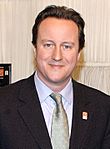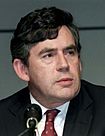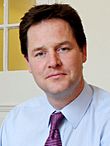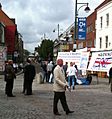United Kingdom general election, 2010 facts for kids
The 2010 United Kingdom General Election was a big event where people across the UK voted to choose who would represent them in the House of Commons of the United Kingdom. This is like choosing a team to run the country. The election happened on May 6, 2010, and 650 people were chosen to become Members of Parliament (MPs).
The three main party leaders at the time were:
 |
 |
 |
| David Cameron Conservative Party Leader |
Gordon Brown Labour Party Leader |
Nick Clegg Liberal Democrat Leader |
|---|
Contents
What Happened After the Election?
The election had an interesting result: a hung parliament. This means that no single political party won enough seats (more than half) to be in charge all by themselves. This hadn't happened in the UK since 1974!
The Conservative Party won the most seats, with 307 out of 650. But this wasn't enough for them to have a majority. So, they decided to team up with another party, the Liberal Democrats. This team-up is called a coalition. Together, the Conservatives and Liberal Democrats had enough seats to form a government. This was the first coalition government in the UK since World War II.
On May 11, 2010, David Cameron, the leader of the Conservative Party, became the new Prime Minister of the United Kingdom. Nick Clegg, the leader of the Liberal Democrats, became the Deputy Prime Minister. Before the election, Gordon Brown, the leader of the Labour Party, was the Prime Minister.
TV Debates
This election was special because it was the first time the leaders of the three main parties had live TV debates together. Millions of people watched them!
- The first debate was about things happening inside the UK. Many people thought Liberal Democrat leader Nick Clegg did the best. After this, support for the Liberal Democrats grew a lot.
- The second debate was about how the UK deals with other countries. In this debate, Nick Clegg and David Cameron were seen as doing well.
- The third and final debate was about money and taxes. Most people thought David Cameron performed the best in this one.
Big Changes in Parliament
The 2010 election brought some big changes:
- The Conservative Party returned to government for the first time since 1997.
- The Liberal Democrats joined the government for the very first time.
- The Green Party of England and Wales won its first ever seat in the House of Commons.
- The Alliance Party of Northern Ireland also won a seat, which was their first since 1974.
Election Results by Party
Here are the final results for the main political parties in the election:
- Conservative Party (306 Members of Parliament, 36.1% of all votes)
- Labour Party (258 Members of Parliament, 29.0% of all votes)
- Liberal Democrats (57 Members of Parliament, 23.0% of all votes)
- UK Independence Party (0 Members of Parliament, 3.1% of all votes)
- British National Party (0 Members of Parliament, 1.9% of all votes)
- Scottish National Party (6 Members of Parliament, 1.7% of all votes) – only in Scotland
- Green Party (1 Member of Parliament, 1.0% of all votes) – only in England and Wales
- Sinn Fein (5 Members of Parliament, 0.6% of all votes) – only in Northern Ireland
- Democratic Unionist Party (8 Members of Parliament, 0.6% of all votes) – only in Northern Ireland
- Plaid Cymru (3 Members of Parliament, 0.6% of all votes) – only in Wales
- Social Democratic and Labour Party (3 Members of Parliament, 0.4% of all votes) – only in Northern Ireland
- Alliance Party of Northern Ireland (1 Member of Parliament, 0.1% of all votes) – only in Northern Ireland
One seat was won by an Independent candidate (someone not part of a political party). The seat of Buckingham was won by John Bercow, who was the Speaker of the House of Commons and not linked to any political party.
Images for kids
-
Nick Griffin, leader of the British National Party, talking to voters in Romford Market.
-
Polling station in Camberwell
-
A polling station in Wetherby, West Yorkshire
See also
 In Spanish: Elecciones generales del Reino Unido de 2010 para niños
In Spanish: Elecciones generales del Reino Unido de 2010 para niños









